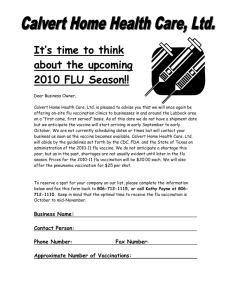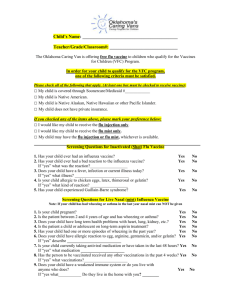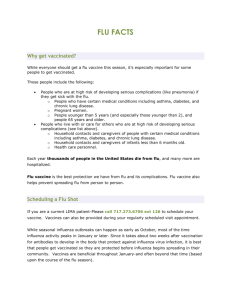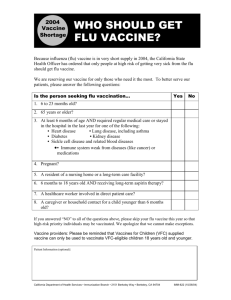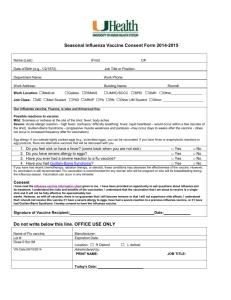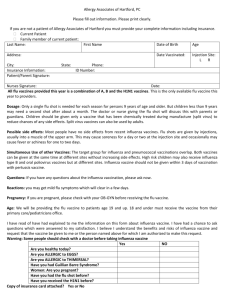Portland Area IHS Influenza Action Plan 2015-2016
advertisement
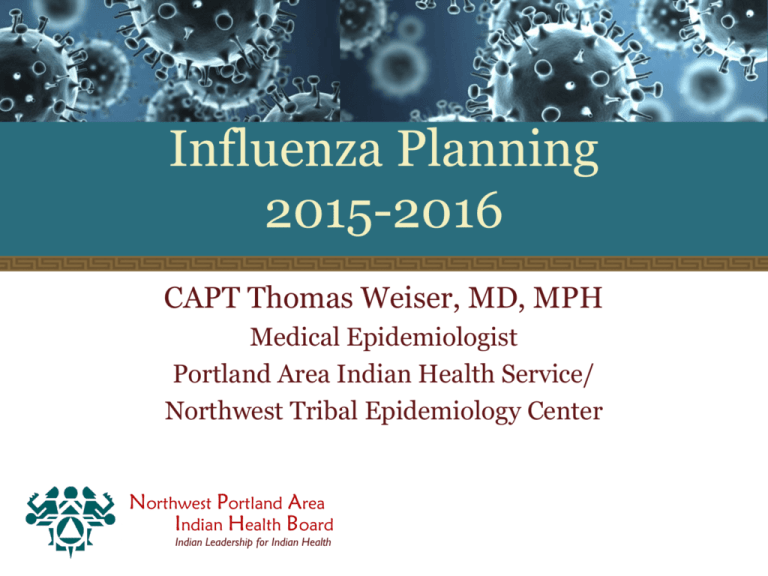
Influenza Planning 2015-2016 CAPT Thomas Weiser, MD, MPH Medical Epidemiologist Portland Area Indian Health Service/ Northwest Tribal Epidemiology Center Northwest Portland Area Indian Health Board Indian Leadership for Indian Health Key Points for Area Immunizations Coordinators/Planners • Use area-level data sources to determine historic flu vaccine coverage and to monitor progress IIAS, CRS, NIRS • Advocate for early vaccination Address concerns about supply availability, waning immunity. • Anticipate adverse media coverage and develop messages to mitigate the effects Decreased coverage because of vaccine mis-match last year led to increased influenza B later in the flu season. IPC IPC CareCare Model DRAFT Model Rationale Community Health Care Organization SelfManagement Support Delivery System Design Safe Efficient Activated Family and Community Informed Activated Patient Decision Support Patient-Centered Equitable Clinical Information Systems Effective EFFECTIVE RELATIONSHIPS Improved health and wellness for American Indian and Alaska Native individuals, families, and communities Timely Prepared, Proactive Community Partners Prepared Proactive Care Team Background • Healthy People 2020 goal: 70% annual influenza coverage • Benefits of annual influenza vaccination: Prevent community-wide spread of influenza Prevent individual cases of influenza, especially vulnerable populations and health-care workers Background • For influenza: Is 70% coverage sufficient? What will it take to reach 70% coverage? Is timing important? • The “right” level of vaccine coverage to prevent widespread transmission of disease is depends on the effectiveness of the vaccine and the infectiousness of the strain of flu virus “An annual seasonal flu vaccine … is the best way to reduce the chances that you will get seasonal flu and spread it to others. When more people get vaccinated against the flu, less flu can spread through that community.” CDC. http://www.cdc.gov/flu/protect/keyfacts.htm Rationale • Vaccine effectiveness 50-52% for ages 6 months to 64 years 37.5% for ages 65 and older • Influenza virus infectiousness R0 for seasonal influenza: 1.2-1.4 R0 for pandemic influenza: 1.4-2.3 Critical vaccination coverage as a function of vaccine effectiveness for given level of Ro Measles >10 Average Seasonal flu: Ro=1.3 1918 Pandemic flu: Ro=2.0 (Adapted from Plans-Rubio, et al, 2012)3 Critical vaccination coverage as a function of vaccine effectiveness for given level of Ro Critical vaccine coverage 0.5-64 years (~40%) Critical vaccine coverage ≥ 65 years (~55%) Healthy People 2020 goal (70%) (Adapted from Plans-Rubio, et al, 2012)3 Methods • Data obtained from IHS Influenza-like Illness Awareness • • • • • System (IIAS) IIAS collects daily reports from participating clinics Includes total daily visits, diagnosis of Influenza-like Illness (ILI) and certain chronic conditions, flu vaccination status, age ILI- defined by 36 ICD-9 codes + fever (T≥100) Data aggregated by IHS Area and disseminated to immunization coordinators weekly Projected models computed based on changes to current timing of vaccination activities and overall capacity of the system Cumulative Percent of Active User Population Receiving Influenza Immunization and ILI Activity Portland Area IHS 2014-2015 Season 6% Cumulative Percent Vaccinated 70% 5% 60% 4% 50% 40% 3% 30% 2% 20% Epidemic threshold of 2% ILI reached 1% 10% ILI starts to increase 0% 0% 8/30 9/13 9/27 10/11 10/25 11/8 11/22 12/6 12/20 1/3 Children (6 months-17 years) 1/17 1/31 2/14 2/28 3/14 3/28 Adults (18 + years) Percent with Influenza-Like Illness (ILI) 80% Weekly count of influenza vaccine doses given in Portland Area IHS for the 2014-15 influenza season Weekly Count of Influenza Immunizations Given, 2014-2015 Season 2500 Period of maximum vaccination activity 2000 1500 1000 Vaccine delivered to clinics 500 0 8/30/2014 9/30/2014 10/31/2014 11/30/2014 Children (6 months-17 years) 12/31/2014 1/31/2015 Adults (18 + years) 2/28/2015 Strategies to increase the uptake of influenza vaccine in the Portland Area IHS 1. Starting sooner: Begin influenza vaccination activities as soon as possible 2. Sustain maximum vaccination rate longer: extend the maximum rate of vaccinations/week throughout the month of 3. Increase weekly vaccination uptake by a defined percentage (e.g, 25%): requires that the clinics/systems adapt to provide more vaccinations/week than last year. 4. Combination Strategies: would use two or more of these strategies in combination. Projected cumulative influenza immunization rates using three single strategies compared to current practice. Healthy People 2020 Goal: 70% vaccinated Minimum herd immunity threshold to be reached by 11/30/2015 is shown in red. All three strategies are projected to show increased coverage but no single strategy will reach the goal of 50% before ILI activity begins nor would they reach HP2020 goal of 70% Projected cumulative influenza immunization rates using three combination strategies compared to current practice Healthy People 2020 Goal: 70% vaccinated Minimum herd immunity threshold to be reached by 11/30/2015 is shown in red. All three strategies could meet/exceed the goal of 50% before ILI activity begins. Recommendations IHS Areas should consider the following: • • • • • • Review local influenza policies and practices Review data on influenza immunization levels in prior years Set goals to achieve immunization levels that approach the IHS/HP2020 goal of 70% coverage for all aged 6 months and older. Consider adopting more than one single strategy Identify the primary and secondary drivers of flu vaccine uptake and adopt new policies and practices aligned with those drivers. At the clinic level: Engage ALL staff in efforts to receive and provide influenza immunizations. Engage patients through media/outreach materials (posters, postcards, PSAs and articles) and open communication. Driver Diagram for Improving Influenza Vaccine Coverage Strategy (Change Concept) Primary Drivers Secondary Drivers Start vaccinating sooner Clinic Readiness Community Readiness Constraints Pre-scheduled walk-in flu Highly dependent on vaccine clinics timely vaccine supply Pharmacists, Mas and delivery to clinic nurses trained and ready to vaccinate All necessary supplies in place prior to arrival of vaccines (gloves, syringes, needles, alcohol wipes, etc) Pre-placed articles/ads in local newspapers about when flu vaccines will be given, benefits of flu vaccines, etc Messaging throughout the community- posters, brochures, PSAs, videomessages, Social Media, radio, etc Community-based vaccine days/sites pre-planned Strategy (Change Concept) Primary Drivers Secondary Drivers Sustain period of maximum vaccination rate longer Clinic Capability Community Demand or Acceptance Ensure adequate staffing throughout the month of November Extend/maintain flu vaccine walk-in clinics Ensure adequate supplies to last for the duration of the extend flu vaccine campaign May need to develop new messaging strategies or repeat messages multiple times Anticipate and provide information about the benefits of flu vaccine specific to any issues that develop (vaccine mis-match, adverse events, reported “severity” of the circulating flu strain, special populations. Constraints Dependent on a sustained demand from patients/community May require additional efforts to vaccinate outside of the clinic Mistrust of IHS/CDC Negative media messages Strategy (Change Concept) Increase weekly number of vaccines given per week by some percent (e.g., by 25%) Primary Drivers Secondary Drivers Clinical systems change to increase capacity Remove barriers to getting flu vaccine (standing orders, walk-in clinics, offering to all patients, etc) Provide multiple types of vaccine (e.g., live attenuated, preservative free, high-dose) Providers educated and committed to providing flu vaccine to all patients Vaccinate providers/staff Create new vaccination venues – evening/weekend, community-based clinics Develop/repeat messaging strategies Anticipate and provide information specific to issues that may develop (vaccine mis-match, adverse events, reported “severity” of the circulating flu strain, special populations). Community Demand or Acceptance Constraints System must increase its daily capacity to give vaccines (staff must work harder than previous years) Staff reluctance to promote vaccine or reluctance to receive their own flu vaccine Insufficient staff to provide evening/weekend vaccination clinics Mistrust of IHS/CDC Negative media messages Resources • NPAIHB Breaking News 2015-2016 Flu Season • www.cdc.gov/flu • https://www.ihs.gov/Flu/ • www.facebook.com/IHSHPDP • www.flu.gov • Wes Studi Flu Video • More CDC Resources Activities so far… • Yellowhawk: Flu Clinics at various locations- senior center, clinic, Governance Center, and at the Casino Posters and flyers throughout the community advertising the availability of flu shots • Makah: Drive-up flu clinic gave about 100 vaccinations Senior Citizens program health fair: about 50 people vaccinated. Next week nurses will go to the public school. • Spokane: Walk-through flu clinic- 55 people vaccinated • Fort Hall: 35 people vaccinated in just 1 hour References 1. 2. 3. Deaths averted by influenza vaccination in the U.S. during the seasons2005/06 through 2013/14. I Foppa, P Cheng, S Reynolds, D Shay, C Carias, J Bresee, I Kim, M Gambhir, A Fry. Article in Press, Vaccine (2015), http://dx.doi.org/10.1016/j.vaccine.2015.02.042 Estimates of the reproduction number for seasonal, pandemic, and zoonotic influenza: a systematic review of the literature. M Biggerstaff, S Cauchemez, Carrie Reed, M Gambhir, Lyn Finelli. BMC Infectious Diseases (2014) 14:480 http://www.biomedcentral.com/1471-2334/14/480 The vaccination coverage required to establish herd immunity against influenza viruses. P PlansRubió. Preventive Medicine (2012) 55:72–77 Contact Information: CAPT Thomas Weiser, MD, MPH tweiser@npaihb.org thomas.weiser@ihs.gov (503) 416-3298 (Office) (503) 927-4467 (Cell)
